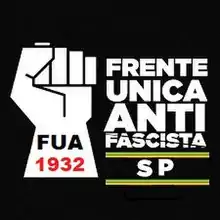Antifascist United Front Frente Única Antifascista | |
|---|---|
 | |
| President | Francesco Frola |
| Founded | June 25, 1933 |
| Dissolved | |
| Headquarters | São Paulo |
| Ideology | Socialism Anti-fascism |
| Political position | left |
| International affiliation | None |
| Colours | Black, Red and White |
The Antifascist United Front (FUA) – [Portuguese: Frente Única Antifascista] was a Brazilian political organization.[1]
History
FUA was founded in São Paulo on 25 June 1933 to oppose fascism, as represented by the Brazilian Integralist Action (AIB). FUA was created on the initiative of Communist League (LC),[2] Brazilian Socialist Party (PSB), Italian anti-fascist immigrants and other leftist organizations. A meeting was held in the hall of the Civic Union 5 de Julho, in which the Anti-fascist United Front was constituted. The meeting was chaired by Francesco Frola. Attending groups included PSB, LC, Union of Graphic Workers, Socialist University Guild, 5 de Julho Civic Legion, Flag of 18, Giacomo Socialist Group Matteotti, O Homem Livre newspaper, A Rua newspaper, O Socialismo magazine, Grupo Italia Libera, São Paulo Workers Federation (FOSP), and the anarchist newspapers A Lanterna and A Plebe. Communist Party of Brazil (PCB) and entities linked to it were invited but did not attend.[3] The anarchists also did not formally participate, although they maintained contacts and aligned with the Antifascist front on some occasions.
FUA, together with other groups, held a series of demonstrations. Its militants played an important role in the Battle of the Praça da Sé. Until February 1934, the year in which the organization ceased activities, FUA edited the newspaper O Homem Livre, the main vehicle of antifascist propaganda of that period.[4]
Throughout 1934 FUA opened space for the formation of a broader range of progressive sectors. The antifascist struggle and the more general struggle for reforms and against conservative forces culminated in the formation of the National Liberation Alliance (ANL) in 1935.[5]
Context
Political radicalization, left and right, was evident in Brazil and the rest of the world. In the 1930s, liberalism was in crisis as a result of events such as the Great Depression, the growth of fascist movements in Europe and the radicalization of communist movements. Liberalism experienced significant competition from other economic and political organization movements, both from the right and from the left, which ended up marginalizing it. The dysfunctional National Constituent Assembly (between 1933 and 1934) resulted in great agitation and turbulence in Brazilian civil society. This became a political issue for elites, middle classes, and workers with socialism, communism, fascism, and anarchism all contending for influence.[1]
See also
References
- 1 2 Castro, Ricardo Figueiredo de (December 2002). "A Frente Única Antifascista (FUA) e o antifascismo no Brasil (1933-1934)". Topoi (Rio de Janeiro). 3 (5): 354–388. doi:10.1590/2237-101X0030050015. ISSN 2237-101X.
- ↑ Figueiredo de Castro, Ricardo (2013). "MÁRIO PEDROSA, LÍVIO XAVIER E AS ORIGENS DO MARXISMO NO BRASIL" (PDF). Marxismo21.org (in Portuguese).
- ↑ Abramo, Fúlvio (2014). The flock of green chickens. A history of anti-fascism in Brazil. Sao Paulo: Veneta
- ↑ Castro, Ricardo Figueiredo de (2010-09-09). "O Homem Livre: um jornal a serviço da liberdade (1933-1934)". Cadernos AEL (in Brazilian Portuguese). 12 (22/23). ISSN 1413-6597.
- ↑ Rodrigues, Andre (2017-12-20). "BANDEIRAS NEGRAS CONTRA CAMISAS VERDES: ANARQUISMO E ANTIFASCISMO NOS JORNAIS A PLEBE E A LANTERNA (1932-1935)". Tempos Históricos (in Portuguese). 21 (2): 74–106. ISSN 1983-1463.